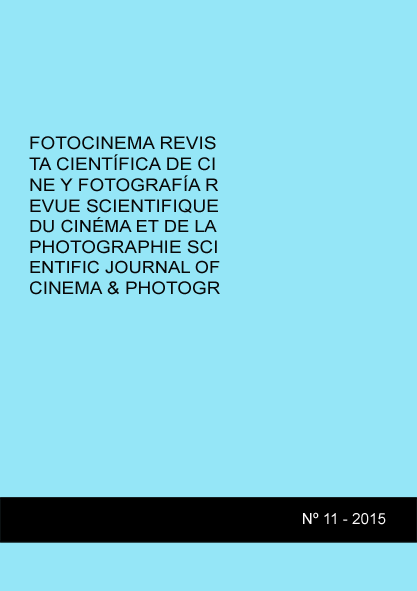Aristóteles en Hollywood: poética y retórica en la narrativa audiovisual
DOI:
https://doi.org/10.24310/Fotocinema.2015.v0i11.6085Abstract
El objeto del presente trabajo es utilizar el modelo retórico propuesto por Aristóteles para crear el marco de una posible retórica de la narrativa audiovisual. Para ello, en primer lugar definiremos el objeto de estudio, aislándolo en la medida de lo posible de otras artes o ciencias hermanas, como la poética o la dialéctica. Seguidamente trataremos alguno de los problemas fundamentales que emergen de la aplicación de un modelo retórico basado en la palabra, a una retórica basada en la imagen sonora y en movimiento, como la dificultad de traducción de un lenguaje a otro o la necesidad de evitar la reducción de la retórica a una de sus partes. Finalmente estableceremos lo que consideramos el marco retórico aristotélico básico (los tres tipos de prueba por persuasión), y lo aplicaremos a la narrativa cinematográfica o audiovisual.
Abstract:
The subject of this paper is to use the rhetorical model proposed by Aristotle to create a framework for a potential rhetoric of audiovisual narrative. For this, first we define the object of study, isolating it as much as possible from other related arts or sciences, as poetic or dialectic. Then we discuss some key issues emerging from the application of a model of rhetoric based in words to a rhetoric based in moving images and sound. We discuss for instance the difficulty of translation from one language to another or the need to avoid the reduction of rhetoric to one of its parts. Finally, we establish what we consider the basic Aristotelian rhetorical frame (the three types of proof by persuasion), and we apply it to audiovisual narrative.
Palabras clave:
Aristóteles; retórica; poética; Hollywood; semiótica; narrativa audiovisual
Keywords:
Aristotle; Rhetoric; Poetics; Hollywood; Semiotics; Audiovisual Narrative
Downloads
Metrics
Downloads
Published
How to Cite
Issue
Section
License
All contents published in Fotocinema Revista científica de cine y fotografía are protected under the Creative Commons Attribution-NonCommercial-ShareAlike 4.0 International (CC BY-NC-SA 4.0) license. All about this license is available in the following link: <http://creativecommons.org/licenses/by-nc-sa/4.0>
Users can copy, use, redistribute, share and exhibit publicly as long as:
- The original source and authorship of the material are cited (Journal, Publisher and URL of the work).
- It is not used for comercial purposes.
- The existence of the license and its especifications are mentioned.
There are two sets of authors’ rights: moral and property rights. Moral rights are perpetual prerogatives, unrenounceable, not-transferable, unalienable, imprescriptible and inembargable. According to authors’ rights legislation, Fotocinema. Revista científica de cine y fotografía recognizes and respects authors moral rights, as well as the ownership of property rights, which will be transferred to University of Malaga in open access. The property rights are referred to the benefits that are gained by the use or the dissemination of works. Fotocinema. Revista científica de cine y fotografía is published in an open access form and it is exclusively licenced by any means for doing or authorising distribution, dissemination, reproduction, , adaptation, translation or arrangement of works.
Authors are responsable for obtaining the necessary permission to use copyrighted images.













13.png)




